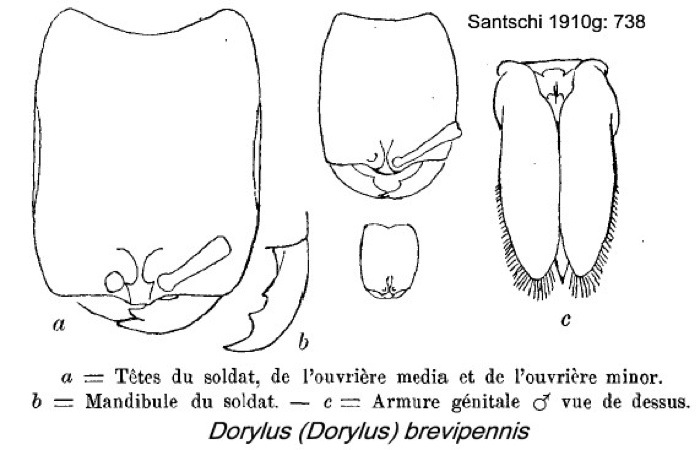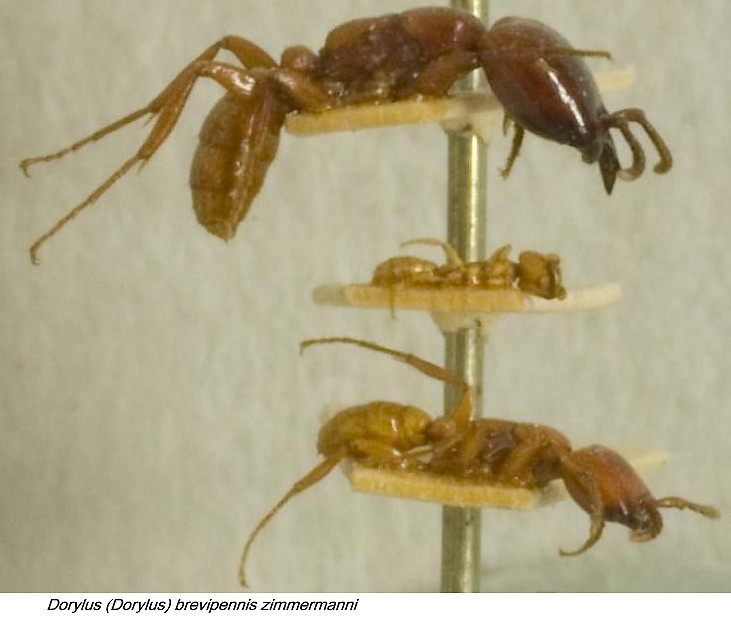Dorylus (Dorylus) brevipennis Emery
 Male Male   Type locality Tanzania
(Dorylus brevipennis n. sp.,
Emery, 1895j: 721, illustrated, male - on linked males page; Emery
1901c: 192, worker; Boven,
1975: 193, queen) types collected at Tabora, Orniyaneimbe, by René
Oberthür, wrongly noted as "Westafrika" Type locality Tanzania
(Dorylus brevipennis n. sp.,
Emery, 1895j: 721, illustrated, male - on linked males page; Emery
1901c: 192, worker; Boven,
1975: 193, queen) types collected at Tabora, Orniyaneimbe, by René
Oberthür, wrongly noted as "Westafrika"
subspecies
marshalli
(Dorylus brevipennis Em. var. Marshalli, Emery 1901c: 193, worker
& male, illustrated) from Zimbabwe, Salisbury &
Mashonaland, H Brauns - on linked worker page
zimmermanni
(Dorylus
brevipennis Em. stirps Zimmermanni
n. st., Santschi, 1910g: 738,
illustrated, soldier,
worker & male, illustrated) from Congo, Madingou, Rev. P.
Zimmermann - see below and linked worker page
unavailable name bulawayensis
(Dorylus affinis Shuck r. Zimmermanni Sant. v. bulawayensis
n. v., Forel, 1914d: 215, worker) from Zimbabwe,
coll G Arnold - no images on Antweb (June 2014)
all forms known (see Bolton, 1995)  . .
|
 Emery's
(1895j) description of the male is at Emery's
(1895j) description of the male is at  . Emery's (1901c) description of the worker
and marshalli is at . Emery's (1901c) description of the worker
and marshalli is at  . Santschi's (1910g) description of zimmermanni
is at . Santschi's (1910g) description of zimmermanni
is at  and and  . Forel's (1914d)
description of bulawayensis is at . Forel's (1914d)
description of bulawayensis is at  . J. van Boven (1975:
189) described the queen from Rubona, Rwanda, collected by H.
Neel, 19.iv.1973, and gave an illustration (right) of the major; see . J. van Boven (1975:
189) described the queen from Rubona, Rwanda, collected by H.
Neel, 19.iv.1973, and gave an illustration (right) of the major; see 
Wheeler (1922) listed many findings from eastern Africa
(from Sudan south to Zululand) and from Zaïre (Kohl; at Medje,
Lang & Chapin).
Bernard (1952) reported it as common at Banco, Ivory
Coast, and a probable identification of a single small worker from Guinea,
Nion (T44, Lamotte).
|
 Arnold (1915: 122)
provided a description of the type,
from Emery (1895j, 1901c) - Arnold (1915: 122)
provided a description of the type,
from Emery (1895j, 1901c) -
"Worker - TL 8.5 mm. This worker is deceptively like that of affinis,
differing only in its smaller size in the major forms, and in having
the petiole shorter and wider behind than in that species."
He noted that it had not been recorded from southern Africa but he gave
a description of the variety marshalli, which was originally
found at Salisbury, Zimbabwe (from Emery, 1901) -
"Worker maxima - TL 8.5 mm; head, 2.8 mm long X 2.3 mm wide. The colour
is a little darker than the type species, and the puncturation of the
petiole, which is less shining, is more abundant. Otherwise like the
type".
On race zimmermani, Arnold wrote -
Major - TL 8 mm. Colour, puncturation and general characters
exceedingly similar to those of helvolus. The sides of the head
are, however, slightly sinuate; the teeth of the mandible more acute,
and the petiole a very little wider. The ventral lamella of the petiole
is produced behind into a short spine, pointing downwards (the lamella
is truncate in helvolus majors.
Worker media - TL 6-3.4 mm. These do not present any appreciable
differences to distinguish them from helvolus of the same size;
the ventral lamella is not spinously produced as in the major. Of the
smallest (2 mm) described by Sanstchi, I have seen no examples; they
have 8-joined antennae".
He noted there was nothing, other than the ventral lamella of the major
petiole that separated them from helvolus. He also cited
Santschi's descriptions of males from Madingou, French Congo.
Arnold gave a translation of the male description - "A
small species, of a somewhat stumpy build. Particularly noticeable on
the head are the small but slightly projecting eyes, which are
separated from the base of the mandibles by a distance about equal to
the thickness of the scape. The mandibles are plainly smaller than in affinis.
The antennae are long, the scape shorter than the first 5 joints of the
flagellum, or about as long as one-third of the latter. Thorax stout,
petiole as in affinis. There are some erect hairs on the
pronotum; on the mesonotum and scutellum only a long, adpressed
pubescence, which is hardly glossy and does not conceal the chitin.
Colour brownish-yellow, head excepting the mandibles dark brown; on the
mesonotum in front the is a short median band of darker colour, and
also two lateral bands which do not reach the anterior margin; the
femora and petiole brown; the margins of the abdominal segments
brownish. Wings noticeably short, glassy and with brown nervures; the
transverse nervule joins the middle of the root of the cubital. The
genital organs are constructed much as in affinis, but the
outer parameres are markedly broad, not excised at all laterally.
Length 20-21 mm; head and thorax, 8 mm; width of thorax, 4 mm; anterior
wings, 12.5 mm.
|
The various morphs are shown in detail on
the Polymorphism
morphs page, with fresh specimens from the Central
African Republic, Cameroun and Sudan.
A separate page shows Males.
|
 Polymorphism Polymorphism
This photomontage of zimmermanni cotypes is
collated from The Smithsonian Institute images at http://ripley.si.edu/ent/nmnhtypedb/public/specimeninfopage.cfm?publicconsumption=1&typespecimenID=972.
|
Oxford University Museum
specimens
Dorylus (Dorylus) brevipennis
B Taylor det.
|
Cameroun
A Fotso Kuate
Sample 36
|
5.vii.2008
Matomb
03°54'30" N
11°25'58" E |
.
|
4
|
 |
Dorylus (Dorylus) brevipennis
B Taylor det.
|
Central African
Republic
P Annoyer
Di-08
|
20.i.2005
Dzanga-Sangha
03°55’13.2" N
16°36’46.1" E
|
U.V : 2h-6h, après
Sefka (entre Bambio et croisement Nola/Berberati), dans layon
forestier;
from on a reduviid bug; in forest, 1st hour of the morning; 536m asl
|
1
|
 |
Dorylus (Dorylus) brevipennis
B Taylor det.
Male
|
Central African
Republic
P Annoyer
KT
|
23.x.2008
Dzanga-Sangha
03°01'49.5" N
16°08'31.7" E
|
18h-6h; Camp 2; 567
m; Sur plate-forme à 40 m du sol dans un kungu, à 50 m du camp
|
1
|
 |
Dorylus (Dorylus) brevipennis
B Taylor det. |
Sudan
Awatif Omer
22
|
2012
Dinder NP
11° N
35° E
|
Major & media
workers
|
4
|
 |
Dorylus (Dorylus) brevipennis
B Taylor det. |
Sudan
Awatif Omer
2013.02.36
|
Damazeen
11˚47'09" N
34˚20'12" E
|
range of workers
|
3
|
 |
|
 Polymorphism Polymorphism
This photomontage is of specimens from Cameroun;
collector A Fotso Kuate (Sample 36).
|
|